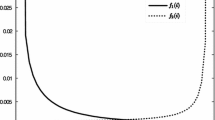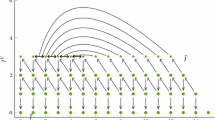Abstract
This paper proposes a block-structured Markov process to describe the spread of epidemics of Susceptible-Infected-Removed (SIR) type. Our purpose is to determine the distribution of the final state of the process and of some other interesting measures of the dimension of the epidemic. The followed modeling approach proves to be simple and systematic. Its flexibility is underlined by the presentation of several specific models that extend the classical general epidemic. Finally, two numerical examples illustrate some of the results obtained.
Similar content being viewed by others
References
Ackleh AS, Allen LJS (2005) Competitive exclusion in SIS and SIR epidemic models with total cross immunity and density-dependent host mortality. Discret Contin Dyn Syst, Ser B 5:175–188
Albrecher H, Thonhauser S (2012) On optimal dividend strategies with a random time horizon. In: Cohen SN, Madan D, Siu TK, Yang H (eds) Stochastic processes, finance and control. A festschrift in honor of Robert Elliott. Advances in statistics, probability and actuarial science, vol 1. World Scientific, Singapore, pp 157–180
Artalejo JR, Economou A, Lopez-Herrero MJ (2013) Stochastic epidemic models with random environment: quasi-stationarity, extinction and final size. J Math Biol 67:799–831
Asmussen S, Avram F, Usabel M (2002) Erlangian approximations for finite-horizon ruin probabilities. ASTIN Bullet 32:267–281
Bacaër N (2016) Le modèle stochastique SIS pour une épidémie dans un environnement aléatoire. J Math Biol 73:847–866
Ball F, O’Neill P (1993) A modification of the general stochastic epidemic motivated by AIDS modelling. Adv Appl Probab 25:39–62
Ball F, O’Neill P (1994) Strong convergence of stochastic epidemics. Adv Appl Probab 265:629–655
Ball F (2018) Susceptibility sets and the final outcome of collective Reed-Frost epidemics Methodol Comput Appl Probab, to appear
Billard L, Zhao Z (1993) The stochastic general epidemic model revisited and a generalization. IMA J Math Appl Med Biol 10:67–75
Daley DJ, Gani J (1999) Epidemic modelling: an introduction. Cambridge University Press, Cambridge
Daniels HE (1990) The time of occurrence of the maximum of a closed epidemic. In: Gabriel J-P, Lefèvre C, Picard P (eds) Stochastic processes in epidemic theory. Proceedings, Luminy 1988. Lecture notes in biomathematics 86. Springer, Berlin, pp 129–136
Diekmann O, Heesterbeek JAP (2000) Mathematical epidemiology of infectious diseases: model building, analysis and interpretation. Wiley, New York
Dietz K (1979) Epidemiological interference of virus populations. J Math Biol 8:291–300
Ed-Darraz A, Khaladi M (2015) On the final epidemic size in random environment. Math Biosci 266:10–14
El Maroufy H, Omari L, Taib Z (2012) Transition probabilities for generalized SIR epidemic model. Stoch Model 28:15–28
El Maroufy H, Driss K, Taib Z (2016) Final outcome probabilities for SIR epidemic model. Commun Stat - Theory Methods 45:2426–2437
Feng R, Garrido J (2011) Actuarial applications of epidemiological models. North Amer Actuar J 15:112–136
He Q-M (2014) Fundamentals of matrix-analytic methods. Springer, New York
Kendall WS, Saunders IW (1983) Epidemics in competition II: the general epidemic. J R Stat Soc, Series B 45:238–244
Latouche G, Ramaswami V (1999) Introduction to matrix analytic methods in stochastic modeling. ASA and SIAM, Philadelphia
Lefèvre C, Simon M (2016) SIR epidemics with stages of infection. Adv Appl Probab 48:768–791
Lefèvre C, Picard P (2017) On the outcome of epidemics with detections. J Appl Probab 54:890–904
Lefèvre C, Picard P, Simon M (2017) Epidemic risk and insurance coverage. J Appl Probab 54:286–303
Lefèvre C, Simon M (2018) Cross-infection in epidemics spread by carriers. Stoch Model 34:166–185
López-Garcia M (2016) Stochastic descriptors in an SIR epidemic model for heterogeneous individuals in small networks. Math Biosci 271:42–61
Neuts MF, Li J-M (1996) An algorithmic study of S-I-R stochastic epidemic models. In: Heyde CC, Prohorov YV, Pyke R, Rachev ST (eds) Athens conference on applied probability and time series analysis. Applied probability in honor of J.M. Gani, vol 1. Springer, New York, pp 295–306
Picard P, Lefèvre C (1993) Distribution of the final state and severity of epidemics with fatal risk. Stochastic Processes and their Applications 48:277–294
Picard P, Lefèvre C (1999) On the algebraic structure in Markovian processes of death and epidemic types. Adv Appl Probab 31:742–757
Saunders IW (1981) Epidemics in competition. J Math Biol 11:311–318
Severo NC (1969) Generalizations of some stochastic epidemic models. Math Biosci 4:395–402
Trapman P, Bootsma MCJ (2009) A useful relationship between epidemiology and queueing theory: the distribution of the number of infectives at the moment of the first detection. Math Biosci 219:15–22
Acknowledgements
We thank the referees for useful comments and suggestions. M. Simon acknowledges the support of the Australian Research Council Center of Excellence for Mathematical and Statistical Frontiers (ACEMS).
Author information
Authors and Affiliations
Corresponding author
Additional information
Publisher’s Note
Springer Nature remains neutral with regard to jurisdictional claims in published maps and institutional affiliations.
Rights and permissions
About this article
Cite this article
Lefèvre, C., Simon, M. SIR-Type Epidemic Models as Block-Structured Markov Processes. Methodol Comput Appl Probab 22, 433–453 (2020). https://doi.org/10.1007/s11009-019-09710-y
Received:
Revised:
Accepted:
Published:
Issue Date:
DOI: https://doi.org/10.1007/s11009-019-09710-y




